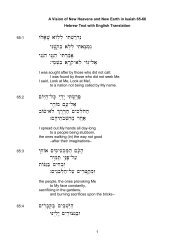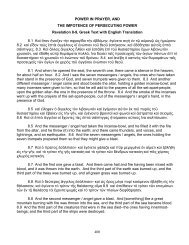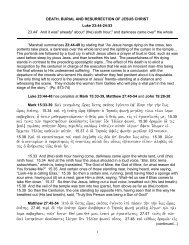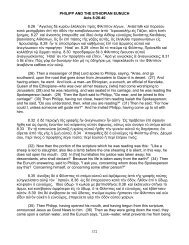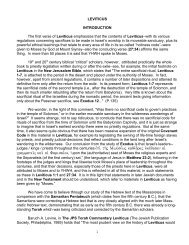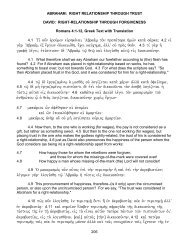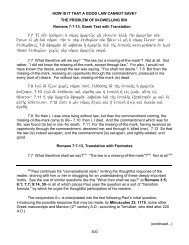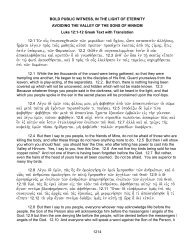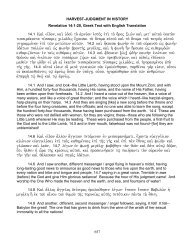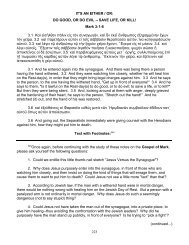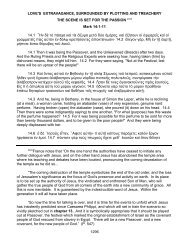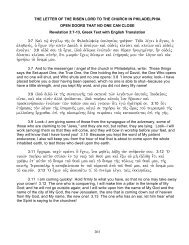714 715 716 717woman, who is in a hemorrhage (for) twelve years, 5.26 and who has suffered much714Following the noun h, gune, “a woman,” the indefinite pronoun tij, tis, “a certainone,” is interpolated into the text by Bezae, Theta, Uncial Manuscript 0132, Family 13 ofMinuscules, the “Majority Text,” the Old Latin Manuscripts a, f and the Syriac tradition.The indefinite pronoun is not read by Sinaiticus, Alexandrinus, Vaticanus,Ephraemi Rescriptus, L, W, Delta, Family 1 of Minuscules, Minuscules 33, 892, 2427,2542, a few other Greek manuscripts, the Latin Vulgate or some of the Old Latin witnesses.It appears to be a later addition to the original text, designed to “enhance” itsreading, but whether read or not makes no difference for the meaning of <strong>Mark</strong>.Following this phrase, "And a woman..." come some seven participles (one presentparticiple, six aorist participles) each introducing a descriptive phrase, enabling a word-pictureof this woman in great detail (we have introduced each participle with "who," in order toindicate this <strong>Mark</strong>an usage). The actual continuation of "And a woman" comes at the end ofverse 27, "...she touched his robe."Taylor notes that "This passage [verses 25-27] is remarkable as being one of the veryfew examples in <strong>Mark</strong> of a longer Greek [sentence] with subordinating participles, in contrastto the repeatedly used...construction [of placing short sentences side by side]." (P. 289)France comments that “The second suppliant, whose social standing is in markedcontrast to that of Jairus, is introduced in a sentence which piles seven participial clauses onone another before reaching the main verb (h` ,yato, epsato) in verse 27. This interestingdeparture from <strong>Mark</strong>’s more usual paratactic [‘the coordination of grammatical elements suchas phrases or clauses without the use of coordinating elements such as conjunctions’] styleallows the reader (or hearer) to build up a sympathetic mental portrait of the woman’s situationbefore her story begins...” (P. 236)715Literally, "...who being in a flow (or, "flowing") of blood..." It is the present participle thatis used here (ïóá, ousa, "being").France comments that “<strong>In</strong> Decapolis Jesus confronted ‘unclean spirits,’ located amongtombs, and appropriately transferred into pigs, as unclean animals. Now back on the westbank he confronts the uncleanness of a menstrual disorder, and (assuming that she really wasdead) of a corpse, and yet in both cases <strong>Mark</strong> records physical contact (verses 27, 41).Since the issue of uncleanness, and of Jesus’ apparently cavalier attitude to the laws ofpurity, will become a central feature of the story in chapter 7, it may be that <strong>Mark</strong> hasdeliberately prepared the way by this sequence of narratives. But it must be confessed thatthe issue is implicit rather than explicit in the account of the woman with the hemorrhage, andif anyone noticed the problem of potential defilement in the case of Jairus’ daughter <strong>Mark</strong>gives no hint of it.” (P. 235)440(continued...)
718 719under many physicians, and who has spent everything she has, and who has profited715(...continued)“Menstrual impurity is a prominent concern in the Old Testament (especially Leviticus15:19-33) and was later to become the subject of a whole tractate of the Mishnah (Niddah;compare also Zabim); defilement through contact with even a normally menstruant womanmust be scrupulously avoided. This woman’s long and fruitless search for a cure wastherefore motivated not only by physical distress but by her social and religious isolation.”(Ibid., p. 236)716Here, the feminine singular aorist active participle is used, ðáèïóá, pathousa, “whohas suffered,” or “having suffered.”717The adjective ðïëë, polla, “many things,” here translated "much" is the same word thatis used in verse 23, where it is translated "over and over." See footnote 707. This word canbe used as either an adjective or an adverb, and as a result can mean "many things" or"greatly," and it is difficult to determine which is meant. Compare <strong>Mark</strong> 5:10 with its footnote660.718For a discussion of the history of medicine and physicians in the ancient world, andespecially in the Jewish and Christian <strong>Bible</strong>s, see the article of Albrecht Oepke inTheological Dictionary of the New Testament, III, pp. 194-215."About the only thing primitive [humanity] can understand as a cause of physicalailment is the wound received in battle. By way of analogy he comes to regard sicknesseswhich he cannot understand as 'attacks.' The assailants suspected are more or lesspersonally conceived evil powers which either strike [humanity] down, bombard him with lesspowerful but more artful shots, or even take possession of him. He expects healing throughthe overcoming of these hostile powers by magic, if necessary by counter-magic, or bypropitiatory offerings." (P. 195)"Medicine first developed among the ancient Egyptians in the third millennium. But itwas the Greeks who first established the art of healing on an empirical and rationalfoundation." Oepke discusses the Ebers Papyrus which describes medical developments inEgypt between 2600-1600 B.C. <strong>In</strong> this document, physicians play a large role, lancing sores,setting broken bones, stitching up wounds, and filling teeth; they prescribed the use of drugs,and even used a primitive inhalation device. Oepke holds that medical science in Egypt laterdegenerated into magic, and rejects the view that medical science developed out of magic.<strong>In</strong> Greece, Oepke finds that "True medicine arises from the 6th century [B.C.] onwardsin the colonies of Asia Minor, Greater Greece and Africa, as the doctors themselves developinto a kind of guild. Doctors are publicly appointed and a special levy is raised to pay them.The Hippocratic oath bears fine witness to the growing ethics of the profession...'I will followthat method of treatment which, according to my ability and judgment, I consider for the benefitof my patients, and abstain from whatever is deleterious and mischievous. I will give nodeadly medicine to anyone if asked, nor suggest any such counsel; furthermore, I will not give(continued...)441
- Page 1 and 2: NOT ONLY THE WIND AND THE WAVES-BUT
- Page 3 and 4: 632(...continued)like a farmer plan
- Page 5 and 6: 633 6345.1 And they came to the oth
- Page 7 and 8: 638(...continued)were haunted by de
- Page 9 and 10: 640(...continued)But even if we are
- Page 11 and 12: Because he had many times been boun
- Page 13 and 14: 647 6485.6 And seeing the Jesus fro
- Page 15 and 16: 652you should not torment me.” 5.
- Page 17 and 18: 660 661 662and over that he should
- Page 19 and 20: 664(...continued)Leviticus 11:7 (th
- Page 21 and 22: 667the pigs, and the herd rushed do
- Page 23 and 24: 676“Legion”; and they were made
- Page 25 and 26: 684 685 686says to him: “Go to yo
- Page 27 and 28: 689 690proclaim in the Ten-City Are
- Page 29 and 30: 691(...continued)Petrine [that is,
- Page 31 and 32: 691(...continued)429
- Page 33 and 34: SIGNS OF THE COMING KINGDOM:SICKNES
- Page 35 and 36: 693 694 6955.21 And when the Jesus
- Page 37 and 38: 700 701 702 703 704[look-] one of t
- Page 39 and 40: 705(...continued)addiction, over wh
- Page 41: 713And a great crowd was following
- Page 45 and 46: 718(...continued)Oepke shows how be
- Page 47 and 48: 724 7255.28 For she was saying that
- Page 49 and 50: 7335.30 And immediately the Jesus,
- Page 51 and 52: 743 744 7455.34 So then he said to
- Page 53 and 54: 749 7505.35 While he is still speak
- Page 55 and 56: 756 757afraid. Only believe!" 5.37
- Page 57 and 58: 763 764did not die, but is sleeping
- Page 59 and 60: 767mother, and those with him, and
- Page 61 and 62: 775 776 777[immediately] with great
- Page 63 and 64: 779(...continued)Anderson, however,
- Page 65: PRAYERLord Jesus, we are learning f



